Resources by Beverley McGuire
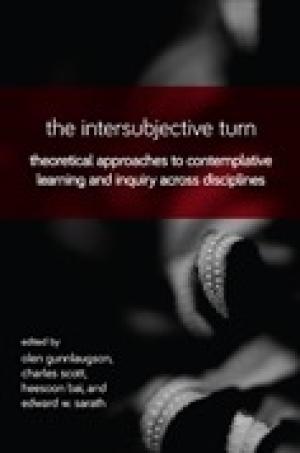
Contemplative pedagogy has become quite popular over the past decade (Jacoby, 2019). This book builds on previous contemplative pedagogical scholarship (Barbezat and Bush, Contemplative Practices in Higher Education, Jossey-Bass, 2014; Simmer-Brown & Grace, Meditation and the Classroom, SUNY Press, 2011), especially a prior volume by the same editors—Contemplative Learning and Inquiry across Disciplines (Gunnlaugson et al., 2014). This book focuses on second-person perspectives or intersubjectivity, which the editors note can be represented spatially as between people, rather than subjectively inside or objectively outside them. It seeks to redress the tendency in contemplative studies to focus on first-person, personal experiences or third-person, objective study and observation of individuals engaged in contemplation. The Intersubjective Turn would interest contemplative studies scholars as well as instructors with a previous background in contemplative pedagogy. Those unfamiliar with contemplative approaches to higher education would benefit from first consulting the work of Barbezat and Bush (Contemplative Practices in Higher Education, Jossey-Bass, 2014) or the previous volume (Gunnlaugson et al., Contemplative Learning and Inquiry across Disciplines, 2014), especially Arthur Zajonc’s overview of contemplative pedagogy in higher education and Harold Roth’s proposed pedagogy for contemplative studies. Although instructors who teach in public universities and colleges may find it challenging to adapt some of the contemplative approaches to their institutional context, those at private institutions and seminaries may encounter less difficulty in applying the contemplative pedagogies discussed. Each article emphasizes the value of incorporating intersubjectivity into one’s contemplative pedagogy and focuses on particular classroom activities that promote such intersubjectivity. Mirabai Bush discusses her “Just Like Me” exercise developed for Google’s Search Inside Yourself program, where participants first engage in self-compassion and then become aware of what they share with others, and her “Mindful Emailing” activity where participants write a response to an email, but before sending it, lean back, take three deep breaths, re-read their response and imagine how it might be received by the other person. David Lee Keiser describes a pedagogical practice that addresses students’ discomfort at being stared at: a “stage exercise” where students mindfully walk to the front of the auditorium, pause and take a breath, make eye contact at least once with everyone in the room, then mindfully walk off stage, taking another breath and then returning to their seat. Lyn Hartley advocates deep dialogue in which students explore uncertainties and questions that no one has answers to, which allows for transformative learning. Judith Simmer-Brown draws on Gregory Kramer’s method of “insight dialogue” to have students sit in dyads, reflecting on challenging aspects of their spiritual or personal journeys as they speak for three minutes and then return to silence and deep listening. David Forbes uses mindfulness as a way for students to reflect on unexamined assumptions and conditioned patterns of thought in order to move towards a postconventional, self-authorized consciousness that tolerates ambiguity and agile thinking. Joanne Gozawa emphasizes the value of students not only doing contemplative practices, but “not doing” them by listening to silence and embodying a posture of receptivity. Other chapters discuss theological and theoretical reasons for engaging in intersubjective contemplative practices, advocating contemplative inquiry as a means of promoting empathetic connection.
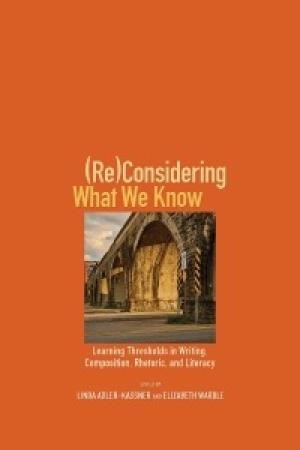
Naming What We Know: Threshold Concepts of Writing Studies, published in 2015, contributed to a discussion about the relevance of identifying key concepts and ideas of writing studies. (Re)Considering What We Know continues that conversation while simultaneously raising questions about the ideas around threshold concepts. Contributions introduce new concepts, investigate threshold concepts as a framework, and explore their use within and beyond writing. Part 1 raises questions about the ideologies of consensus that are associated with naming threshold concepts of a discipline. Contributions challenge the idea of consensus and seek to expand both the threshold concepts framework and the concepts themselves. Part 2 focuses on threshold concepts in action and practice, demonstrating the innovative ways threshold concepts and a threshold concepts framework have been used in writing courses and programs. Part 3 shows how a threshold concepts framework can help us engage in conversations beyond writing studies. (Re)Considering What We Know raises new questions and offers new ideas that can help to advance the discussion and use of threshold concepts in the field of writing studies. It will be of great interest to scholars and graduate students in writing studies, especially those who have previously engaged with Naming What We Know. (From the Publisher)
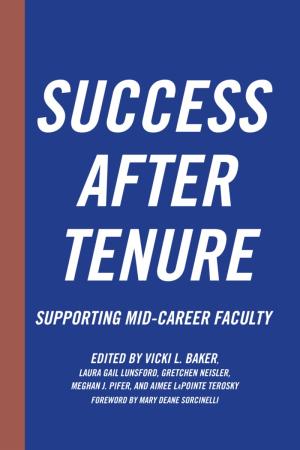
This book brings together leading practitioners and scholars engaged in professional development programming for and research on mid-career faculty members. The chapters focus on key areas of career development and advancement that can enhance both individual growth and institutional change to better support mid-career faculties. The mid-career stage is the longest segment of the faculty career and it contains the largest cohort of faculty. Also, mid-career faculty are tasked with being the next generation of faculty leaders and mentors on their respective campuses, with little to no supports to do so effectively, at a time when higher education continues to face unprecedented challenges while managing continued goal of diversifying both the student and faculty bodies. The stories, examples, data, and resources shared in this book will provide inspiration--and reality checks--to the administrators, faculty developers, and department chairs charged with better supporting their faculties as they engage in academic work. Current and prospective faculty members will learn about trends in mid-career faculty development resources, see examples of how to create such supports when they are lacking on their campuses, and gain insights on how to strategically advance their own careers based on the realities of the professoriate. The book features a variety of institution types: community colleges, regional/comprehensive institutions, liberal arts colleges, public research universities, ivy league institutions, international institutions, and those with targeted missions such as HSI/MSI and Jesuit. Topics include faculty development for formal and informal leadership roles; strategies to support professional growth, renewal, time and people management; teaching and learning as a form of scholarship; the role of learning communities and networks as a source of support and professional revitalization; global engagement to support scholarship and teaching; strategies to recruit, retain, and promote underrepresented faculty populations; the policy-practice connection; and gender differences related to key mid-career outcomes. While the authors acknowledge that the challenges facing the mid-career stage are numerous and varying, they offer a counter narrative by looking at ways that faculty and/or institutions can assert themselves to find opportunities within challenging contexts. They suggest that these challenges highlight priority mentoring areas, and support the creation of new and innovative faculty development supports at institutional, departmental, and individual levels. (From the Publisher)
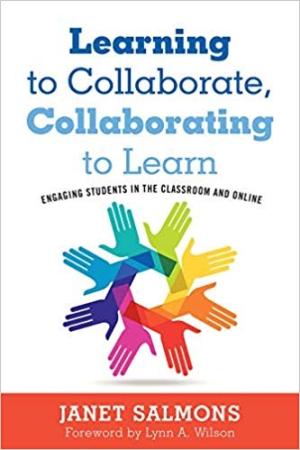
Students who know how to collaborate successfully in the classroom will be better prepared for professional success in a world where we are expected to work well with others. Students learn collaboratively, and acquire the skills needed to organize and complete collaborative work, when they participate in thoughtfully-designed learning activities. Learning to Collaborate, Collaborating to Learn uses the author’s Taxonomy of Online Collaboration to illustrate levels of progressively more complex and integrated collaborative activities. - Part I introduces the Taxonomy of Online Collaboration and offers theoretical and research foundations. - Part II focuses on ways to use Taxonomy of Online Collaboration, including, clarifying roles and developing trust, communicating effectively, organizing project tasks and systems. - Part III offers ways to design collaborative learning activities, assignments or projects, and ways to fairly assess participants’ performance. Learning to Collaborate, Collaborating to Learn is a professional guide intended for faculty, curriculum planners, or instructional designers who want to design, teach, facilitate, and assess collaborative learning. The book covers the use of information and communication technology tools by collaborative partners who may or may not be co-located. As such, the book will be appropriate for all-online, blended learning, or conventional classrooms that infuse technology instructional techniques. (From the Publisher)

I distinctly remember what my husband said when he found me typing an email to a student in the middle of the night, the glow of my laptop illuminating my face in the darkness: “You need to set better boundaries.” Suffering from insomnia–whether it was in the late stages of pregnancy or the first year of night feedings, I can’t remember–I rationalized my behavior by saying that I was being productive since I was up already, and that the student seemed genuinely distraught by the state of their paper in light of a pressing deadline. In fact, his words resonated profoundly with my own sense of being out of balance. Online teaching can blur the boundaries between our work and our lives. People readily remark that online courses take a long time to design and develop, but less time to administer. In other words, they are more frontloaded than face-to-face courses. However, communication and interaction with students over email, Skype or Zoom, or even face-to-face can also place considerable demands on our time during the course of the semester. Because we can virtually correspond anytime and anyplace, it is easy to find oneself replying to students during times that one would not even entertain the possibility of a face-to-face meeting. An added pressure is that online students consider prompt responses and feedback from their instructor crucial and an indication that they care. On their evaluations students report greater satisfaction when they receive prompt replies to their emails. Yet we do a disservice when we reply as soon as we see their email, regardless of the time of day. Although this might create a greater sense of satisfaction on the part of our students, it fuels the idea that instructors are constantly “on call” and undermines their own capacity to delay gratification, which is a crucial skill for self-regulated learning. Moreover, when they see that we have emailed in the middle of the night, they may conclude that it’s all right to prioritize other things over sleep, rest, and wellbeing. We lose the opportunity to model to our students a more balanced, mindful approach to our communication and interaction. Mindfulness encourages us to cultivate an embodied presence, receptivity, and awareness of ourselves and our surroundings, so that instead of immediately reacting to what we experience, we can instead create space for a more thoughtful response. We may overlook our bodies as we interface with digital devices and screens, but as Linda Stone has observed through the phenomena of “email apnea” – the temporary absence or suspension of breathing, or shallow breathing, when doing email (https://www.huffpost.com/entry/just-breathe-building-the_b_85651 )– our online interactions have physical, emotional, and cognitive ramifications. By immediately replying to students’ emails, I was failing to address my own sleep habits, and I was not giving the space for students to try to resolve their problems by themselves. In the case of students who had clearly procrastinated and emailed me an hour or two before a deadline, one could even argue that I was encouraging bad habits. Aiming for a quick turnaround, I was being reactive rather than responsive. A more mindful approach would have aligned my online communication with the expectations laid out in my syllabus, where I explain that email is my preferred method of contact, and that they should expect a reply within 24 hours. Those parameters allow for balance: one can establish hours to be offline. Admittedly, we may still find the need to accommodate students even when it impinges on our personal lives. Once I found myself emailing back and forth with a student, trying to clarify the expectations of the final project, when he suddenly asked, “Can we talk over the phone?” Although I was at my parents’ house, I felt bad and agreed to call. Bracing myself for the potential of a half-hour interruption, I dialed his phone number. After responding to various questions I hung up and looked at my phone. It had taken less than ten minutes. This made me realize that we should take advantage of multiple channels of communication with our students. In another case, a student asked if we could meet face-to-face to discuss his ePortfolio for the course. We sat together looking at his laptop, and he scrolled through some of the ePortfolio pages to ask about my comments and suggestions. Again, within a very short span of time, I was able to address all of his concerns . . . and meet the student in person. These kinds of interactions with students–over the phone, via Zoom or Skype, or in person–not only show that we care about our students, but they contribute to a greater sense of embodied presence. Although I still have a long way to go, I have found myself trying to be a more mindful online teacher, for the sake of both myself and my students.

ePortfolios are web-based, student-generated collections of their work and reflections on their learning and growth. They are tools for students to synthesize and integrate their learning, inside and outside of the classroom, by critically reflecting on their academic and co-curricular experiences. I first learned about ePortfolios from George Kuh who visited our campus in the fall of 2016 and mentioned that they were the latest addition to the list of High Impact Practices that deepen student learning (https://www.aacu.org/leap/hips). As Bret Eynon and Laura Gambino note, ePortfolios can facilitate student inquiry into their own learning, reflection on their development and growth, and integration across disciplines, as well as curricular and co-curricular contexts (2017, 20). As repositories of student work, ePortfolios allow students to reflect on their academic learning at various stages of their undergraduate development. They facilitate critical reflection which has been theorized as a four-stage reflective cycle (presence in experience, description of experience, analysis of experience, and experimentation; Rogers 2002) or a three-step sequence (describing experiences objectively, examining experiences in light of learning goals, and articulation of learning that includes goals for future action; Ash & Clayton 2009). In ePortfolios, students can describe their work (research papers, leadership positions, etc.), analyze how it has contributed to their growth and development, and experiment with various future possibilities by tailoring their ePortfolios for different career paths and job opportunities. I have used ePortfolios in several different courses: first year seminars, upper-level seminars, directed individual study, and capstone courses. ePortfolios allow seniors and recent graduates to showcase their work, and they have been shown to improve performance in job interviews because students can readily recall what they have done over the course of their undergraduate career and cite specific examples of their transferrable skills. In my capstone course, I had students create a type of ePortfolio that included pages about themselves, their signature work, their co-curricular activities, their resume, and their contact information. On their signature work page, I had them describe their capstone project for the general public and reflect on what they had learned in their program. ePortfolios can be powerful for first year students as well. Some institutions, such as Indiana University-Purdue University Indianapolis (IUPUI) include ePortfolios within their first-year-experience programs. They have students create ePersonal Development Plans (ePDP) that enable students to increase awareness of themselves and others, set self-concordant goals, develop hope, and shape education and career plans (https://eportfolio.iupui.edu/). When students create ePortfolios in their first year, they can build on it over time, reflect on what they have learned at various points in their undergraduate career, and chart different pathways when their personal and professional goals change. They can generate robust repositories of what they have learned in their academic and co-curricular experiences. Not unexpectedly, the ePortfolios from my first year seminar were less developed than my capstone course. First year students, navigating new terrain and trying to get their bearings, reflected on what they did in high school and what they hoped to pursue in college. Some had clearly defined goals and career aspirations, while others were uncertain and open to various trajectories. But I think the ePortfolio served two important purposes: first, it clearly demarcated their new identity as a college student, and second, it allowed them to reflect on what they wanted to get out of their college experience in a private forum. Although most free ePortfolios–such as Weebly, Wix, and Wordpress–are public, subscription ePortfolio platforms such as Digication, Pebble Pad, and Taskstream allow students to keep their ePortfolios completely private, share with particular individuals (such as their instructors or classmates), share it within their university, or make it publicly accessible. Many students find such privacy to be novel. When I asked my first-year students if they kept journals or did any reflective writing, I was surprised when only one student raised her hand. The rest said that they used social media such as Facebook, Instagram, or Finsta (a hidden Instagram shared among friends). Instead of engaging in private reflection, they were posting and performing on public or semi-public websites. As a result, many found ePortfolios to be unfamiliar territory, because there was no clearly defined audience, with the exception of myself, who would check to make sure that they were completing their pages, awarding all or no credit. For upper-level seminars and directed individual studies, I have had students create ePortfolios that were more closely tied to the course content. A student researching Aikido created one as a public website with an introduction to Aikido, an annotated bibliography of scholarly resources, and reflections on his personal experience. For my Buddhism course, they reflected on what they learned in the course, uploaded their scholarly review paper, and also wrote about their research for a more general audience. Questions to consider: Do you feel familiar with and comfortable using the ePortfolio platform? What campus resources and support are available for you and your students? For what purpose do you envision using the ePortfolio–for students to reflect on a paper/project, learning process, or academic development? Does your course seek for students to integrate their learning across various contexts or over time? If so, how might you use ePortfolios for this integrative learning? What prompts might you include in your ePortfolio to encourage the kind of integration, reflection, and synthesis that you would like to see? For example, you might ask what insights they gained from an assignment, how it connects to other goals, or how it contributes to their understanding of the discipline or their career development. References: Ash, Sarah L. and Patti H. Clayton. 2009. Generating, deepening, and documenting learning: The power of critical reflection for applied learning. Journal of Applied Learning in Higher Education, 1(1), 25-48. Eynon, Bret and Laura M. Gambino. 2017. High-Impact ePortfolio Practice: A Catalyst for Student, Faculty, and Institutional Learning. Sterling, VA: Stylus. Rodgers, Carol. 2002. “Defining Reflection: Another Look at John Dewey and Reflective Thinking,” Teachers College Record 104, no. 4:842-866.
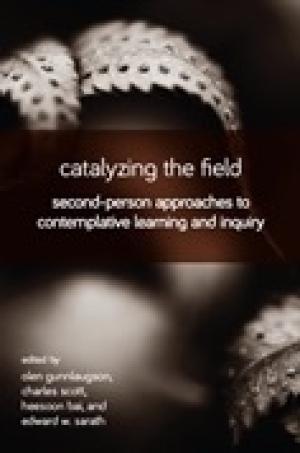
A rich collection of essays about the inner, shared experiences of participants engaged in second-person approaches to contemplative practice. Catalyzing the Field presents a diverse series of applied case studies about the second-person dimension of contemplative learning in higher education. As a companion volume to the editors’ previous book, The Intersubjective Turn, the contributors to this book explore various pedagogical scenarios in which intentional forms of practice create and guide consciousness. Their essays demonstrate that practice is not only intellectual, but somatic, phenomenological, emotional, and spiritual as well. Along with their first book, Contemplative Learning and Inquiry across Disciplines, the editors craft an essential body of work that affirms the fundamental importance of contemplative practice in institutions of higher learning. (From the Publisher)
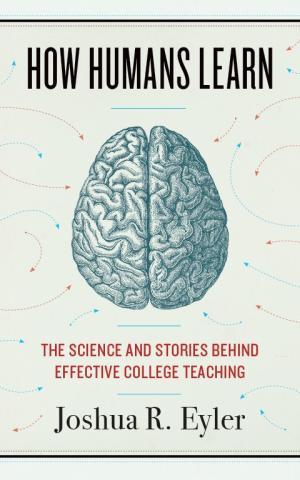
How Humans Learn argues that our natural systems for learning are connected to human evolution and psychological development, and a better understanding of the way humans learn can help determine what will and will not work in the classroom. Instead of presenting evidence of why a teaching or learning strategy works, Eyler identifies five patterns of learning drawn from psychology, evolutionary biology, and neuroscience to explain why students learn more when certain techniques are chosen over others: curiosity, sociality, emotion, authenticity, and failure. He draws on seminal works in the scholarship of teaching and learning such as that of Bain (What the Best College Teachers Do, 2004) and Fink (Creating Significant Learning Experiences, 2013), and his patterns overlap with principles of learning identified by other scholars (Ambrose et al., How Learning Works, 2010; Davis & Arend, Facilitating Seven Ways of Learning, 2013). In each chapter Eyler offers examples of classroom practice from various disciplines in Western higher education and provides helpful “key takeaways” that summarize major points and highlight practical suggestions. For example, to stimulate curiosity we can incorporate inquiry, discussion-based pedagogies, and backward design that structures courses from the outset so that every element is tied to an essential question that our course helps students answer (Wiggins & McTighe, Understanding by Design, 2005). To promote sociality, we can use collaborative learning strategies, peer instruction, storytelling, and role-immersion games such as Reacting to the Past. To ensure that emotions guide thinking rather than undermine it, we can demonstrate the relevance of the material and embody “pedagogical caring” by giving frequent feedback, having high expectations for students, and coming to class prepared. To encourage an authentic learning experience, we can allow students to engage in applied problem solving, incorporate experiential and service learning, and bring our own research into the classroom. Finally, we can allow students opportunities to fail when the stakes are low, then give them support and guidance to understand from failure and cultivate growth mindsets, grit, agency, and other resiliency strategies. Those fascinated by evolutionary developmental biology will likely enjoy the entire book, while others may gravitate towards particular chapters that address topics of interest. Eyler mentions religion only once in the book, during discussion of the “emotional trauma” that can result when students alter knowledge structures or “mental models” tied to their personal beliefs and deeply held convictions (192), but his discussion of “cognitive realism” – when the brain registers a situation as being realistic – also poses interesting challenges for instructors of religion (154). Theological education affords various types of immersive experiences for students, but what sorts of “authentic activities” and “immersions” might instructors of religious studies offer students, especially those who teach in public colleges and universities? Although there are clearly opportunities to apply tools and methodologies from the study of religion to conduct field research or wrestle with problems of the world (155), what characteristics would make other assignments or activities “compellingly” real (157) without being religious?

I distinctly remember what my husband said when he found me typing an email to a student in the middle of the night, the glow of my laptop illuminating my face in the darkness: “You need to set better boundaries.” Suffering from insomnia–whether it was in the late stages of pregnancy or the first year of night feedings, I can’t remember–I rationalized my behavior by saying that I was being productive since I was up already, and that the student seemed genuinely distraught by the state of their paper in light of a pressing deadline. In fact, his words resonated profoundly with my own sense of being out of balance. Online teaching can blur the boundaries between our work and our lives. People readily remark that online courses take a long time to design and develop, but less time to administer. In other words, they are more front loaded than face-to-face courses. However, communication and interaction with students over email, Skype or Zoom, or even face-to-face can also place considerable demands on our time during the course of the semester. Because we can virtually correspond anytime and anyplace, it is easy to find oneself replying to students during times that one would not even entertain the possibility of a face-to-face meeting. An added pressure is that online students consider prompt responses and feedback from their instructor crucial and an indication that they care. On their evaluations students report greater satisfaction when they receive prompt replies to their emails. Yet we do a disservice when we reply as soon as we see their email, regardless of the time of day. Although this might create a greater sense of satisfaction on the part of our students, it fuels the idea that instructors are constantly “on call” and undermines their own capacity to delay gratification, which is a crucial skill for self-regulated learning. Moreover, when they see that we have emailed in the middle of the night, they may conclude that it’s all right to prioritize other things over sleep, rest, and wellbeing. We lose the opportunity to model to our students a more balanced, mindful approach to our communication and interaction. Mindfulness encourages us to cultivate an embodied presence, receptivity, and awareness of ourselves and our surroundings, so that instead of immediately reacting to what we experience, we can instead create space for a more thoughtful response. We may overlook our bodies as we interface with digital devices and screens, but as Linda Stone has observed through the phenomena of “email apnea” – the temporary absence or suspension of breathing, or shallow breathing, when doing email (https://www.huffpost.com/entry/just-breathe-building-the_n_85651) –our online interactions have physical, emotional, and cognitive ramifications. By immediately replying to students’ emails, I was failing to address my own sleep habits, and I was not giving the space for students to try to resolve their problems by themselves. In the case of students who had clearly procrastinated and emailed me an hour or two before a deadline, one could even argue that I was encouraging bad habits. Aiming for a quick turnaround, I was being reactive rather than responsive. A more mindful approach would have aligned my online communication with the expectations laid out in my syllabus, where I explain that email is my preferred method of contact, and that they should expect a reply within 24 hours. Those parameters allow for balance: one can establish hours to be offline. Admittedly, we may still find the need to accommodate students even when it impinges on our personal lives. Once I found myself emailing back and forth with a student, trying to clarify the expectations of the final project, when he suddenly asked, “Can we talk over the phone?” Although I was at my parents’ house, I felt bad and agreed to call. Bracing myself for the potential of a half-hour interruption, I dialed his phone number. After responding to various questions I hung up and looked at my phone. It had taken less than ten minutes. This made me realize that we should take advantage of multiple channels of communication with our students. In another case, a student asked if we could meet face-to-face to discuss his ePortfolio for the course. We sat together looking at his laptop, and he scrolled through some of the ePortfolio pages to ask about my comments and suggestions. Again, within a very short span of time, I was able to address all of his concerns . . . and meet the student in person. These kinds of interactions with students–over the phone, via Zoom or Skype, or in person–not only show that we care about our students, but they contribute to a greater sense of embodied presence. Although I still have a long way to go, I have found myself trying to be a more mindful online teacher, for the sake of both myself and my students.
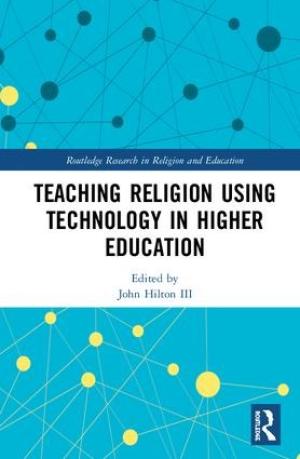
This edited volume – the first of its kind – is incredibly valuable for teachers interested in integrating particular technologies into their classrooms. Among the hundreds of scholarly articles and dozens of books about how to incorporate technology into teaching and learning, such as Michelle Miller’s Minds Online (2016, Harvard University Press) and José Antonio Bowen’s Teaching Naked (2012, Jossey-Bass), some articles have focused specifically on the teaching and learning of religion. For example, recent scholarship has shown how 360-degree cameras and virtual reality headsets allow students to become visually immersed in distant religious environments, facilitating an empathetic understanding and ethnographic analysis of religious place, ritual, and behavior (Johnson, “Using virtual reality,” Teaching Theology and Religion 21[2018]: 228-241). Another article looks at how social media technologies might increase student engagement and active learning, for example, when students tweet about experiences of martyrdom from the perspective of the martyr, the crowd, and the persecutors, and compare types of media used to communicate from a position of power and political or social vulnerability (Warren, “Teaching with Technology,” Teaching Theology and Religion 19 [2016]: 309-319). However, this is the first edited volume on the topic that explicitly addresses those who teach religion in higher education, and as someone who studies digital technologies and uses them for various pedagogical purposes, I thoroughly enjoyed reading it. I appreciated the diversity of technologies discussed, and the candor with which scholars acknowledged that not all technologies enhance or improve student learning. Richard Newton discusses strategies for using mobile devices as learning tools, such as providing backchannels (otherwise known as “live-tweeting”) for students to discuss and address questions while watching in-class films. David Kniep has students create podcasts interviewing religious practitioners, describing how the course challenged or deepened their prior understanding, and connecting scriptural texts to their contemporary world. Renate Hood argues that student response systems can increase student motivation, enhance classroom interaction, and lower students’ apprehension about engaging with religious, ethical, and personal topics. Kristy Slominski shows how clickers can encourage students to take stances on complex religious issues and acknowledge the range of perspectives within the classroom. Kyle Oliver discusses a variety of new media tools to help students visualize sacred sites, including virtual reality technologies such as Google Expeditions, Sites in 3D, and Google Earth, and online videos and picture repositories such as Sacred Destinations and Folkways. Scholars also address how to leverage social media practices in and out of the classroom. Rob O’Lynn emphasizes the relational quality of social media. Brooke Lester identifies both positive and negative outcomes of social media use: while it can help students form connections and communities, it limits anonymity and sometimes subjects users to online abuse. Anthony Sweat shows how blended learning can help students achieve lower-order outcomes outside of class so that they can focus on higher-order outcomes of analyzing, evaluating, and creating in the classroom. Christopher Heard and Steven Rouse demonstrate that integrating interactive fiction stories did not increase motivation among students, suggesting that not all technology adaptation will improve learning outcomes. Finally, contributors explore ways that technology can expand the classroom, for example, through virtual guest lectures with experts in the field or through massive online open seminars.
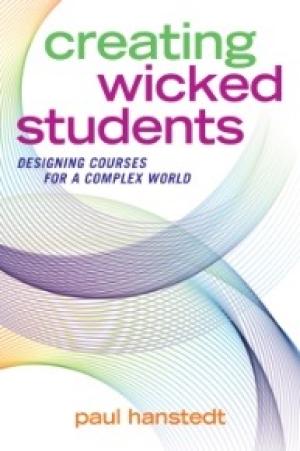
Creating Wicked Students: Designing Courses for a Complex World Paul Hanstedt Sterling, VA: Stylus Publishing, 2018 (x + 180 pages, ISBN 978-1-62036-697-4, $24.95) One might assume that a text called Creating Wicked Students would discuss types of “wicked” problems – complex social-environmental issues that cannot be solved with existing modes of inquiry and decision-making – that instructors might address through a problem-based learning approach. However, this work actually is an introduction to course design most useful for beginning instructors or those redesigning their courses according to sound pedagogical principles. Situating himself against those who view higher education as solely preparing students for the workforce or transmitting content, Hanstedt emphasizes the importance of instilling a sense of authority in our students by helping them develop skills and attitudes that will empower them to make meaningful change in the world. Hanstedt’s holistic vision of education includes attitudes and dispositions alongside skills and content mastery, and will likely resonate with instructors in religious studies and theology. Although he does not explicitly refer to our disciplines, he does offer examples, anecdotes, and insights from colleagues in a variety of fields and institutions, which is a strength of the book. He references seminal work in the scholarship of teaching and learning – including that of: George Kuh (2008, High-Impact Educational Practices, AACU); James Zull (2002, The Art of Changing the Brain, Stylus); and David Krathwohl (2002, “A revision of Bloom’s taxonomy,” Theory into Practice 41) – but does not engage with previous scholarship on wicked problems. Readers interested in learning more about pedagogical approaches to wicked problems could consult the work of the work of: Brown et al. (2010, Tackling Wicked Problems, Routledge); Carcasson (2017, “Deliberative Pedagogy as Critical Connective” in Deliberative Pedagogy, Michigan State University); or Lee (2016, “Systems Thinking,” in Resilience by Design, Springer). This book could be useful as an introduction to course design for someone less familiar with the fundamentals, such as how to develop measurable learning outcomes, align course goals with institutional goals, nest content within higher-order goals, engage students’ prior knowledge, or incorporate applied learning. The structure of the book allows for one to follow it step-by-step as a course design manual, and it also includes recursive “intermissions” to encourage reflection along the way. In addition, his discussion of how to prompt critical thinking through multiple-choice exams offers helpful strategies for encouraging students to explain their thinking on ambiguous questions with follow-up questions that explain or justify their choice (92-98).

Time and time again, I find that successful online students are those with skills of self-direction, self-regulation, and time-management. Self-directed learners determine their learning needs, set learning goals, locate and access suitable resources for learning, manage their learning activities, monitor and evaluate their performance, and reflect on and reassess their learning strategies. Self-directed learners have skills of self-regulation—this encompasses concentration, self-awareness, self-discipline, time-management, delaying gratification, and self-assessment. However, as Sandie Gravett notes in her blog post, students often feel ill equipped for self-directed learning (https://www.wabashcenter.wabash.edu/2018/09/becoming-a-better-teacher/). How do we encourage students to assume responsibility for their learning and become self-directed learners? It takes more than signposts and reminders. For many years, I signaled the importance of these skills by linking to websites such as "What Makes a Successful Online Student" which states: “With the freedom and flexibility of the online environment comes responsibility. The online process takes a real commitment and discipline to keep up with the flow of the process.” I also encouraged them at the beginning of the semester to write down all of their deadlines in a scheduler. I would even email them reminders each week. And still, I found some students fail simply because they fell behind: they prioritized other courses and responsibilities, or they procrastinated and left it until a later time that never came. Online environments can exacerbate tendencies towards procrastination and distraction. We can find endless rabbit holes online that fuel procrastination and undermine our efforts at self-discipline (as Tim Urban humorously depicts in his popular blog post on procrastinators, https://waitbutwhy.com/2013/10/why-procrastinators-procrastinate.html). We are also prone towards continuous partial attention–the process of paying simultaneous attention to numerous sources of information, but at a superficial level. Unlike multitasking, which is driven by a desire to be productive and efficient, continuous partial attention is motivated by the desire to continuously connect and be connected in an effort not to miss anything. As Linda Stone remarks, “It is an always-on, anywhere, anytime, anyplace behavior, and it involves an artificial sense of constant crisis” (https://lindastone.net/qa/continuous-partial-attention/). Our students have a fear of missing out (“FOMO”), and their attention is often interrupted by notifications and alerts on their cell phones. Although we have no control over our students’ behavior and whether they will ultimately succumb to the pull of distraction and procrastination, we can incorporate various activities in our online courses to encourage them to develop skills of self-directed learning. For example, you can facilitate greater self-awareness of their study habits and learning strategies by assigning introspective writing exercises where they answer questions such as: What tasks am I currently procrastinating? Is it because I’m unsure of how to do them, or afraid of doing them poorly? What activities do I gravitate to when I procrastinate? (Nilson 2013, 83) Here I share a few strategies drawn primarily from Linda Nilson’s Creating Self-Regulated Learners: Strategies to Strengthen Students’ Self-Awareness and Learning Skills (Stylus, 2013). Again, self-regulation refers to a sub-skill of self-directed learning: how students approach learning tasks in our online courses. You can introduce them to self-regulated learning from the outset by assigning a reading such as Robert Leamnson’s (2002) article, “Learning (Your First Job)” available through the University of Georgia Center for Teaching and Learning: http://www.ctl.uga.edu/uploads/main/mainLearningYourFirstJob.pdf. It begins by emphasizing that learning is “not something that just happens to you, it is something that you do to yourself,” and then shares strategies for focusing attention, managing one’s time, studying, and preparing for exams. You can encourage students to set goals for their learning by having them write a paper at the beginning of the course entitled “How I Earned an A in This Course” (Zander and Zander 2000). This exercise encourages students to envision concrete and attainable goals for their learning, and it also gives you a sense of their hopes for the course. You can have students revisit them at the end of the semester, reflecting on the extent to which they followed their strategic plan, when, how, and why they might have strayed, and how this impacted their actual performance in the course. You can help them self-test their understanding of the course materials through reflective writing and visual mapping tools. You can do “learning logs” where they identify the main points of each reading, what they found most surprising, what they found most confusing, and why they found it confusing (Bean 2011). Or you could have them write double-column notes on the readings: one column with substantive notes similar to those of “learning logs” but another for their personal reactions (feelings, attitudes, values, beliefs, perspectives, prior knowledge, changes in their way of thinking). (Nilson 2013, 27) You can have them test their understanding through “mind dumps,” where they write down all they can remember about the readings, videos or podcasts, or have them create visual study tools that map out, integrate, and structure what they’ve learned (Nilson 2013, 33). After you give students feedback on their work, you can have them complete meta-assignments that ask them to explain what they think our feedback means (Nilson 2013, 56), or write a letter to the next class about the paper or project: how to prepare for tackling the assignment, what strategies to take, what missteps to avoid, and the value of the assignment (Nilson 2013, 56). Finally, you can have students reflect on their learning through course “wrappers”: at the beginning of the course, students write what they think the subject matter or discipline is about, how it’s done, and why it’s important, and then at the end of the course they revisit those questions and compare their answers (Nilson 2013, 87). Another closing activity might be short “Future Uses” papers where they identify the three most important concepts or skills they learned in the course, why they consider them important, and how they might use them in the future (Nilson 2013, 88; Svinicki 2004). These are just some ways that we might help students develop skills of self-direction, self-regulation, and time-management so that they can be successful in our online courses. Works Cited Bean, John C. 2011. Engaging ideas: The professor’s guide to integrating writing, critical thinking, and active learning in the classroom (Second Edition). San Francisco: Jossey-Bass. Nilson, Linda. 2013. Creating Self-Regulated Learners: Strategies to Strengthen Students’ Self-Awareness and Learning Skills. Sterling, V.A.: Stylus. Svinicki, Marilla D. 2004. Learning and motivation in postsecondary classrooms. San Francisco: Jossey-Bass. Zander, Rosamund Stone and Benjamin Zander. 2000. The Art of Possibility. Boston, MA: Harvard Business School Press. min Zander. 2000. The Art of Possibility. Boston, MA: Harvard Business School Press.